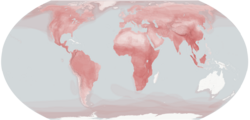
Back Roofdier Afrikaans ስጋበል Amharic Carnivora AN لواحم (رتبة) Arabic كارنيڤورات ARY لواحم ARZ Carnivora AST ВахӀшиял хӀайванал AV Cottoradunol (Carnivora) AVK Yırtıcılar Azerbaijani
| Carnivorans | |
|---|---|
 | |
| Various carnivorans, with feliforms to the left, and caniforms to the right | |
| Scientific classification | |
| Domain: | Eukaryota |
| Kingdom: | Animalia |
| Phylum: | Chordata |
| Class: | Mammalia |
| Clade: | Carnivoramorpha |
| Clade: | Carnivoraformes |
| Order: | Carnivora Bowdich, 1821[2] |
| Suborders | |

| |
| The extant distribution and density of Carnivora species. | |
| Synonyms | |
|
list of synonyms:
| |
Carnivora (/kɑːrˈnɪvərə/ kar-NIH-vər-ə) is an order of placental mammals that have specialized in primarily eating flesh, whose members are formally referred to as carnivorans. The order Carnivora is the sixth largest order of mammals,[22] comprising at least 279 species on every major landmass and in a variety of habitats, ranging from the cold polar regions of Earth to the hyper-arid region of the Sahara Desert and the open seas. These mammals have a large array of diverse body plans with a wide diversity of shapes and sizes.
Carnivora are divided into two suborders, the Feliformia, containing the true felids and several "cat-like" animals; and the Caniformia, containing the true canids and many "dog-like" animals. The feliforms include the Felidae, Viverridae, hyena, and mongoose families, the majority of which live only in the Old World; cats are the only exception, occurring in the old world and the new world, entering the Americas via the Bering Land Bridge. The caniforms include the Caninae, Procyonidae, bears, mustelids, skunks and pinnipeds that occur worldwide with immense diversity in their morphology, diet and behavior.
- ^ Foley, N. M.; Mason, V. C.; Harris, A. J.; Bredemeyer, K. R.; Damas, J.; Lewin, H. A.; Eizirik, E.; Gatesy, J.; Karlsson, E. K.; Lindblad-Toh, K.; Zoonomia Consortium; Springer, M. S.; Murphy, W. J. (2023). "A genomic timescale for placental mammal evolution". Science. 380 (6643). eabl8189. doi:10.1126/science.abl8189. PMC 10233747. PMID 37104581.
- ^ Bowditch, T. E. 1821. An analysis of the natural classifications of Mammalia for the use of students and travelers J. Smith Paris. 115. (refer pages 24, 33)
- ^ Zagorodniuk, I. (2008) "Scientific names of mammal orders: from descriptive to uniform" Visnyk of Lviv University, Biology series, Is. 48. P. 33-43
- ^ Zagorodniuk, I. (2014) "Changes In Taxonomic Diversity Of Ukrainian Mammals For The Last Three Centuries: Extinct, Phantom And Alien Species" Proceedings of the Theriological School, Vol. 12: 3–16
- ^ Haeckel, Ernst (1866.) "Generelle Morphologie der Organismen." Berlin: Georg Reimer.
- ^ J. L. Wortman (1901.) "Studies of Eocene Mammalia in the Marsh Collection, Peabody Museum." The American Journal of Science, series 4 12:193-206
- ^ Kalandadze, N. N. and S. A. Rautian (1992.) "Systema mlekopitayushchikh i istorygeskaya zoogeographei [The system of mammals and historical zoogeography]." Sbornik Trudov Zoologicheskogo Muzeya Moskovskogo Goschdarstvennoro Universiteta 29:44–152.
- ^ Georges Cuvier, Pierre André Latreille (1817.) "Le Règne Animal Distribué d'après son Organisation, pour Servir de Base à l'Histoire Naturelle des Animaux et d'Introduction à l'Anatomie Comparée" Déterville libraire, Imprimerie de A. Belin, Paris, 4 Volumes
- ^ Félix Vicq-Dazyr (1792.) "Encyclopédie Méthodique, Vol. 2: Système Anatomique, Quadrupèdes" Panckoucke
- ^ Arthur Sperry Pearse, (1936) "Zoological names. A list of phyla, classes, and orders, prepared for section F, American Association for the Advancement of Science" American Association for the Advancement of Science
- ^ G. G. Simpson (1952) "For and Against Uniform Endings in Zoological Nomenclature" in "Systematic Zoology Vol. 1, No. 1 (Spring, 1952)", pp. 20-23, Published By: Taylor & Francis, Ltd.
- ^ Kenneth E. Kinman (1994.) "The Kinman System: Toward a Stable Cladisto-Eclectic Classification of Organisms: Living and Extinct, 48 Phyla, 269 Classes, 1,719 Orders", Hays, Kan. (P. O. Box 1377, Hays 67601), 88 pages
- ^ O. S. Vyalov (1966.) "Sledy Zhiznedeyatel'nosti Organizmov i ikh Paleontologicheskoye Znacheniye [Traces of Vital Activity of Organisms and their Paleontological Significance]" Naukova Dumka, Kyiv, 1-219
- ^ Hough, J. R. (1953.) "Auditory region in North American fossil Felidae: Its significance in phylogeny." United States Geological SurveyProfessional Papers, 243-G,95–115.
- ^ Rafinesque, Constantine Samuel (1815). "Analyse de la Nature ou tableau de l'univers et des corps organisés". 1815. Palermo, Aux dépens de l'auteur, 223 pp.
{{cite journal}}: Cite journal requires|journal=(help) - ^ Johann Karl Wilhelm Illiger (1811.) "Prodromus Systematis Mammalium et Avium." Berlin: Sumptibus C. Salfeld, xviii, 301 pages
- ^ Gray, J. E. (1821). "On the natural arrangement of vertebrose animals". London Medical Repository. 15 (1): 296–310.
- ^ Mekayev, Y. A. (2002.) "The faunagenesis and classification of mammals." Petrov’s Academy of Sciences and Arts, St. Petersburg, 1–895.
- ^ Cite error: The named reference
Linnaeus1758was invoked but never defined (see the help page). - ^ Johann Friedrich Blumenbach (1791.) "Handbuch der Naturgeschichte. Vierte auflage." Göttingen, Johann Christian Dieterich, xii+704+[33] pp., 3 pls.
- ^ Leonard Radinsky (1977.) "Brains of early carnivores." Paleobiology, Volume 3, Issue 4, pp. 333 - 349
- ^ "Higher Taxonomy". ASM Mammal Diversity Database. American Society of Mammalogy. Retrieved 22 August 2024.